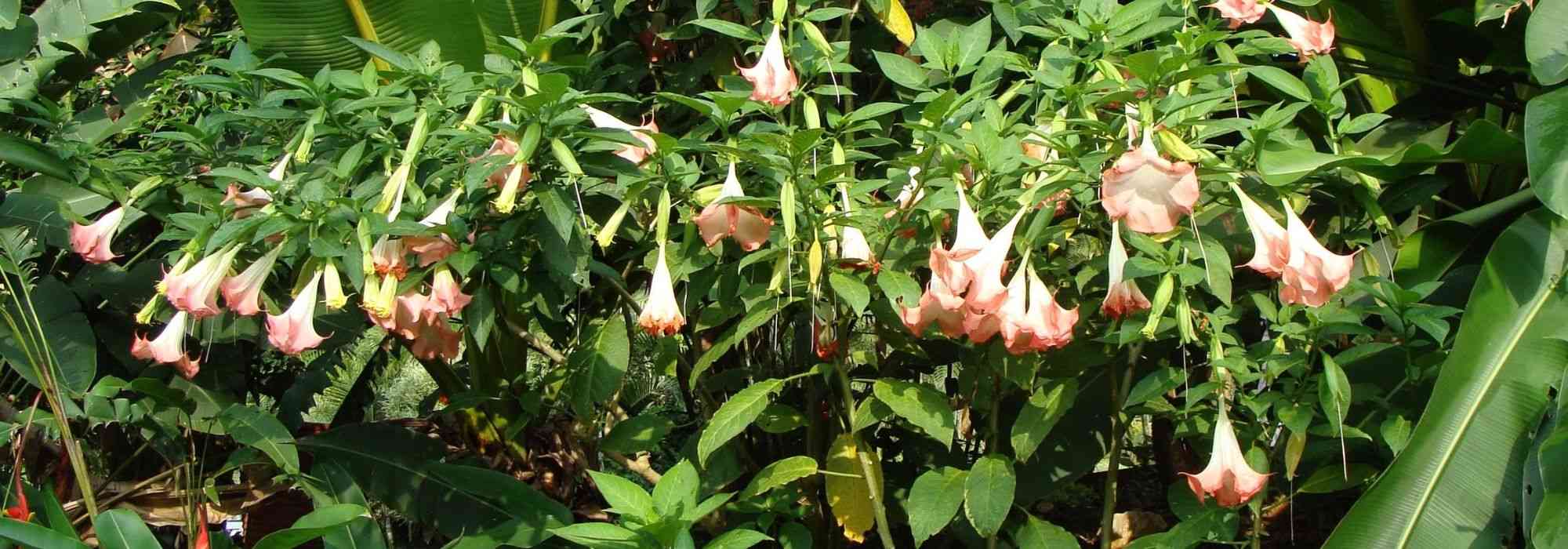
Datura and Brugmansia: sowing, planting, and caring for them
Contents
Datura, in a nutshell
- There are two kinds of Datura: arborescent, whose true name is Brugmansia and which is most often grown in a pot, and herbaceous Datura, annual or perennial, which is usually sown.
- They produce large trumpet-shaped flowers, pendulous or erect, very spectacular and fragrant throughout summer.
- With very rapid growth, arborescent forms are very impressive because of their size, even though they re-emerge entirely from the ground after a slightly cold winter.
- These plants, easy to grow even on poor, polluted soil, are highly toxic if ingested and must be treated with caution if you have young children.
A word from our expert
Daturas, sometimes nicknamed “Angel’s Trumpet”, include two types of plants, arborescent and herbaceous, which belong to family Solanaceae just like tomato, pepper and belladonna. The first form small, very ramified trees or large bush of 2 to 6 m, evergreen or semi-evergreen, much appreciated in summer for their long pendulous flowers, white, golden-yellow or orange-red and very fragrant in evenings. The latter are short-lived herbaceous forms that can regrow from stump for a few years if protected with thick mulch. They are ideal plants to fill a bed with poor, light, sandy or loamy soil in record time.
Besides their herbaceous nature, Datura are distinguished from Brugmansia by erect or horizontal flowers, smaller in size, and by thorny fruits.
Daturas in broad sense are generous plants in foliage, in flowering and in nocturnal scents, which explains enthusiasm for this type of tropical-appearing plant despite notorious toxicity (just like oleander). Flowering is very spectacular between July and October. However, in open ground, flowering of Brugmansia often starts late in season, around end of summer when stems have had to fully reconstitute after a frost. It is therefore preferable to grow it in pot to shelter it over winter and to advance its flowering. You will be charmed by powerful, slightly narcotic perfume of its flowers when evening comes. Herbaceous Daturas, less demanding in water, have advantage of growing very fast from seeds even in poor soil. Warning all parts of plant are toxic. Avoid mixing them with vegetable plants and placing them within reach of young children. Wild species, Datura stramonium (jimsonweed or thorn-apple), is also beautiful in flower but is particularly toxic and requires strict precautions (gloves and mask) for uprooting.

Datura (herbaceous, upright trumpet-shaped flower) and Brugmansia (arborescent, pendulous trumpet)
Description and botany
Botanical data
- Latin name Datura, Brugmansia
- Family Solanaceae
- Common name Datura, devil's weed, angel's trumpets
- Flowering July to October
- Height between 0.50 and 5 m
- Sun exposure sun or partial shade
- Soil type ordinary to rich, well-drained, even calcareous
- Hardiness low (0 to -7 °C)
Brugmansia or arborescent daturas are plants of Central and South America while the genus Datura in the strict sense occurs in tropical, subtropical and warm-temperate regions of the Americas but also in Asia (southern China), Africa, Europe and Australia. The former comprises 6 species distinguished by large pendulous flowers, non-spiny fruits (rare in cultivation) and a long lifespan of several decades. With thick, rather sparsely branched shoots, they can reach 5–6 m in height and 2–3 m in spread in warm, humid conditions if not cut back by frost each year. The latter, herbaceous in habit, have retained the scientific name Datura and include 12 species. These non-woody perennials with short life regrow easily in mild climates from the stump formed by a tuberous root and form a bush 1 to 1.50 m across within 2–3 months.
Daturas carry numerous vernacular names that invite caution: devil’s weed, angel’s trumpets, trumpet of the Last Judgment, fool’s trumpet, thorn apple… It is true that the Datura group includes species that are extremely toxic (narcotic and poisonous), even by simple contact, in particular the common thorn-apple.
Datura stramonium is an annual species of American origin that is increasingly found in France in floodplains, downstream of large urban areas. It is recognisable by its upright white trumpet-shaped flowers and its very spiny fruits, green then beige, about 5 cm in diameter. Its spontaneous presence very often indicates that the soil is polluted, whether by urban, industrial or agricultural pollution caused by pesticides or fertilisers, or by an excess of salts (compacted soils of coastal regions or excessively irrigated soils).
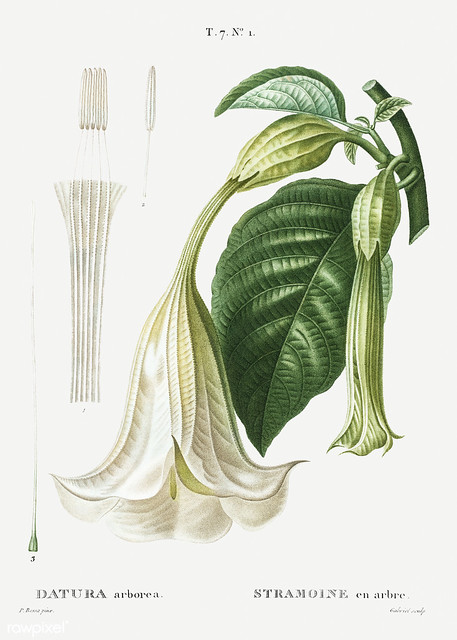
Brugmansia arborea – botanical illustration
It is strongly recommended not to touch it and to wear gloves and a mask if you need to uproot it because of its narcotic content. Note that honey produced from Datura stramonium nectar can cause poisoning, as can fumes released by burning the plant. By contrast, species Datura innoxia (syn. Datura meteloides) and Datura metel, sold as seeds for ornamental gardens, are less poisonous — as the name innoxia (meaning “inoffensive”) indicates — although caution is still advisable, as with Brugmansia.
Brugmansia and Datura belong to family Solanaceae, like tomatoes, tobacco, potato, and also deadly nightshade and mandrake, dubbed witch’s plants because of their toxicity.
The foliage, about twenty centimetres long, is alternate and deciduous in our climate. In Brugmansia the lamina is pale green, velvety and soft, ovate with smooth margins on the adult leaf, with a few teeth in juvenile stages. In Datura the leaves are entire or with angular margins, the lamina very veined and often puckered, dark green to bluish, borne on branched stems often tinged purple or dark red. They measure between 5 and 20 cm long by 4 to 15 cm wide. The foliage emits a fetid odour when touched. Variegated cultivars exist. The two species sold for ornament, Datura innoxia and Datura metel, are very similar but differ in the number of secondary veins arising from the central vein of each leaf.
The flowers, generally numerous but solitary, arise from a large elongated pale green bud that splits down the middle. The corolla with 5 fused petals forming a funnel of varying length widens considerably, reaching up to 18 cm in diameter and 30 cm long in hybrid Brugmansia. Colour ranges from pure white to pale pink and pale golden yellow as in Brugmansia arborea, vivid orange in B. sanguinea and intense purple sometimes mixed with white in Datura metel. Petals bear a central vein and end in a curved tip, giving the flower a horned trumpet appearance. In double-flowered varieties the opening of the flowers is very spectacular when the spiralled petals unfurl. The corolla is preceded by a fused calyx forming a greenish tube or a collar (Datura innoxia). The sweet perfume released by datura flowers in the evening and during the night has earned them the name “angel’s trumpets”. Their flowers are frequently visited by pollinators such as nocturnal moths, hummingbirds and bats.
The spherical capsules of herbaceous Daturas are remarkable for their spiny surface (not pricking while the fruit is still green), earning them the nicknames “thorn apple” or “stinking chestnut”. When drying, the fruits change from green to beige then split open to release black seeds about 2 mm in size. In Brugmansia the fruits are smooth and fleshy, sometimes very long and thin. It is rare to see these fruits in cultivation here, especially since many hybrids grown are infertile. Brugmansia arborea is the only self-fertile species capable of producing fruit here.

Development of a Datura flower
Datura metel and Datura innoxia are medicinal plants at low doses (for rheumatic conditions, anti-inflammatory…), but are above all known for their hallucinogenic effects, used in ritual ceremonies by Aztec and Navajo peoples in North America (D. innoxia) and in India (D. metel).
Main varieties of Datura
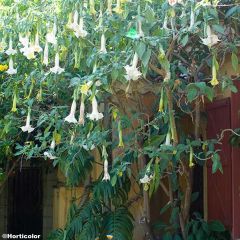
Brugmansia arborea
- Flowering time August to December
- Height at maturity 2 m
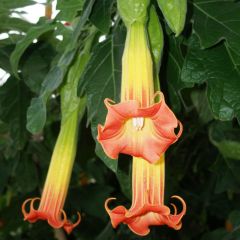
Brugmansia sanguinea - Red Angel's Trumpet
- Flowering time July to November
- Height at maturity 2 m
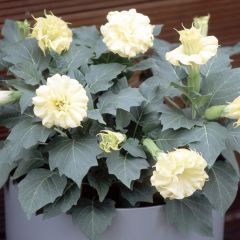
Datura metel Double Golden Queen Seeds - Brugmansia
- Flowering time August to November
- Height at maturity 1,40 m
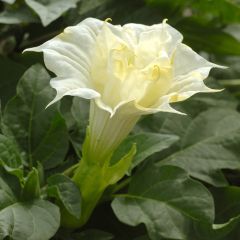
Datura metel Double White Lady Seeds - Brugmansia
- Flowering time August to November
- Height at maturity 80 cm
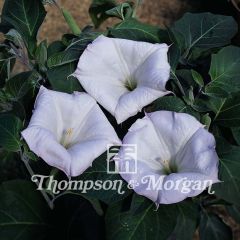
Datura metel Evening Fragrance Seeds - Brugmansia
- Flowering time August to November
- Height at maturity 1 m
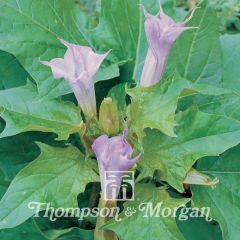
Datura meteloides La Fleur Lilac Seeds - Brugmansia
- Flowering time August to November
- Height at maturity 45 cm
Discover other Datura seeds
View all →Available in 1 sizes
Available in 1 sizes
Available in 1 sizes
Available in 1 sizes
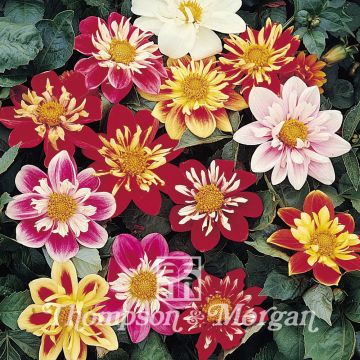
Available in 1 sizes

Available in 1 sizes
Available in 1 sizes
Planting
Where to plant Datura?
To plant a Brugmansia in open ground, a mild climate is required such as on the Mediterranean rim or along the Atlantic coast. Choose a warm, sunny spot sheltered from cold and wind. Brugmansias require a rich, deep soil and regular watering in summer. However the soil must be well drained to help the stump withstand frost (down to -7°C maximum for Brugmansia sanguinea, reputed to be the hardiest of the Brugmansias). You can perfectly grow Brugmansia in a large pot 40 to 50 cm in diameter which can produce young plants 1.40 m across by the end of the season.
Les Datura herbacés peuvent se semer sur un talus bien ensoleillé au nord de la Loire ou à mi-ombre dans le Midi, sur sol ordinaire récemment retourné même calcaire et sec en été s’il est assez profond. Ils peuvent contribuer à l’assainissement d’un sol pollué, coloniser une friche et les bords des routes. La plante émet une racine tubéreuse qui redoute le gel et les excès d’eau. Vous pourrez protéger la souche à l’aide d’un paillis pour favoriser la repousse l’année suivante ou bien ressemer des graines au printemps. Cette plante est rustique en zone 9 (0 à -7°C).
When to plant?
Plant or sow Daturas in spring as they need warmth to develop.
How to plant?
This plant is very easy to grow, whether Brugmansia or Datura, although requirements differ.
Brugmansia aurea, arborea, x candida…
- Dip the Brugmansia pot into a bucket of water to soak it thoroughly and untangle the roots if they have started circling the pot.
- Dig a wide hole at least three times wider than the rootball and up to 50 cm deep.
- Add a few shovelfuls of compost or well‑rotted manure or one to two handfuls of organic fertiliser to the soil. In a pot, choose a good potting compost such as geranium compost, taking care to put gravel or clay balls at the bottom of the pot to a depth of 5 cm.
- Place the plant in the planting hole.
- Replace the soil and firm gently.
- Water thoroughly then mulch.
Datura metel, innoxia (meteloides)…
You can grow Datura as a perennial either by buying young plants or by sowing yourself (see Sowing). You can also grow it as an annual, pulling up the young plant at the end of summer, in a container or in open ground.
- Work the soil deeply as the plant likes well‑worked soil.
- Level the surface then dig a hole the size of the rootball.
In a pot, make a mix of 2/3 good potting compost to 1/3 river sand for Brugmansias, 50% potting compost to 50% sand for Daturas.
Caring for Datura and Brugmansia
- Water Brugmansia generously as their lush foliage consumes a lot of water. Don’t hesitate to add fertiliser for flowering plants if the plant is in a pot.
- You can overwinter Brugmansia in a conservatory at a moderate temperature of 10–15°C or higher to prolong its flowering. If short on space, a dark room (garage, cellar…) protected from frost also works: leaves will fall and you can reduce branches. Young plant may regrow from ground level if stems have frozen.

It is possible to reduce the branches before overwintering your Brugmansia
- Repot in autumn or in spring into a larger pot, or simply refresh the surface compost if you keep the plant in the same large container.
- Perennial datura is well suited to summer drought. Water only if foliage is completely wilted at the end of the day.
- In winter, protect the stump with a thick mulch that will insulate it from both frost and moisture. Its root is sensitive to excess moisture.
- If in a pot, water frequently.
- Don’t forget to remove datura fruits before they disperse their seeds to avoid being overrun. Remember to wear gloves and a mask when handling these plants. Wash your hands thoroughly after contact.
Propagation: propagation by cuttings, sowing
Simplest propagation method is to propagate Brugmansia by cuttings in summer and sow Datura in February–March.
Propagation by cuttings
Propagation by cuttings can be carried out in a glass of water or in a pot.
- Prepare a deep pot by filling it with potting compost mixed with sand.
- Take herbaceous shoot tips about 15 cm long, free of buds or older wood.
- Remove leaves from near base of cutting.
- Insert these for two-thirds of their length, avoiding contact between them.
- Firm potting compost gently all around to eliminate air pockets and ensure good contact between potting compost and cutting.
- Place them in a humid, shaded environment, for example by covering them with a cut clear plastic bottle.
- In autumn, separate rooted cuttings and pot them, keeping them under glass until spring.
Sowing
Datura seeds can remain in soil for several years before finding favourable conditions for germination.
- Soak Datura seeds in a bowl of lukewarm water for 24 hours.
- Sow in moist potting compost, spacing seeds 5 cm apart.
- Cover with 5 mm of fine compost and firm lightly with a board.
- Keep at a temperature of 15–20°C in a bright location.
- Germination will take between 21 and 60 days. Growth will be faster afterwards.
- Prick out seedlings when they reach about 10 cm.
- Water each plant carefully without allowing water to stagnate in saucers placed under pots.
Flowering occurs in summer, from July to October, about four months after sowing.
Uses and companion plants
Datura, and especially shrubby datura are spectacular specimens usually placed as solitary plants in middle of lawn or against sunny wall of the house to enjoy their nocturnal fragrance during summer evenings.
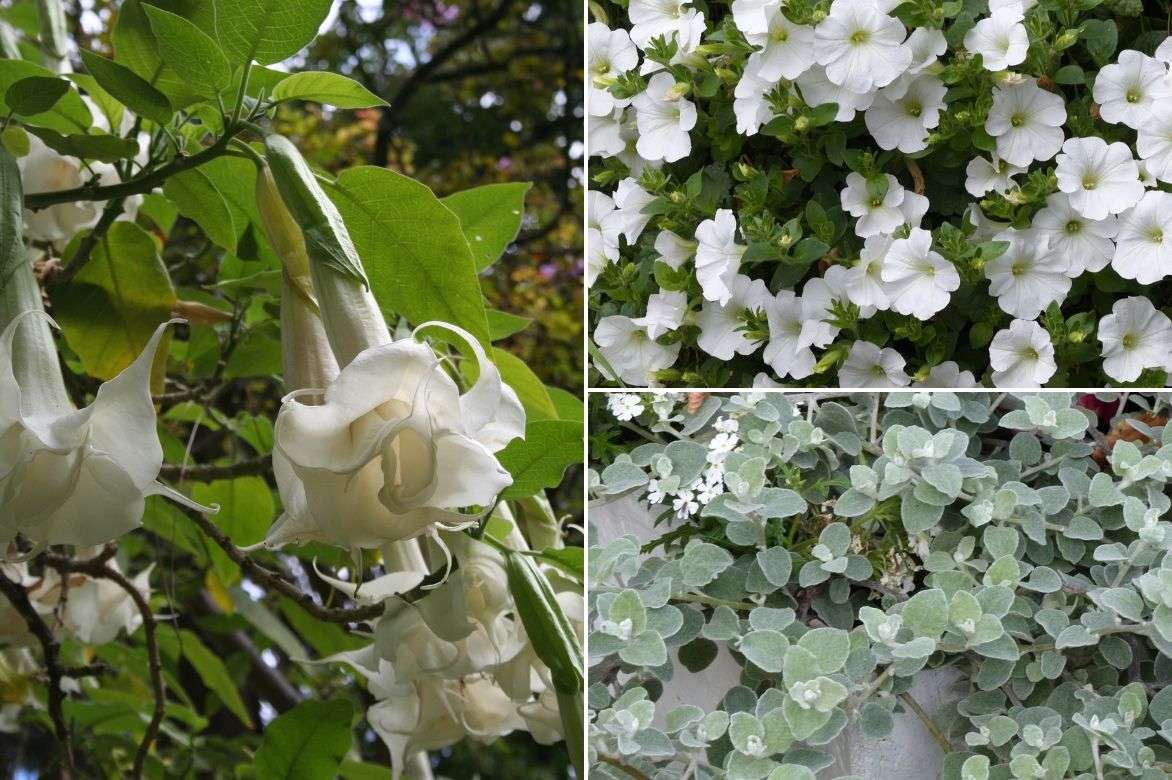
An example of a combination in a large sunlit pot: Brugmansia arborea, Petunia Surfinia ‘Snow’ and Helichrysum petiolare at its base
Placed in a tub or large pot, it will dominate a sun-exposed terrace, for example with Mauritanian bindweed (Convolvulus sabatius) or Impatiens to carpet its base. Herbaceous Datura such as Evening Fragrance can adorn edges of a path alongside four o’clocks (Mirabilis jalapa), equally easy to to grow as they can regrow from tubercles each year like Datura. You can also adorn base of a small tree such as crape myrtle (Lagerstroemia) or cover a newly created bank by scattering seed.
Further reading
Discover our range of Datura.
- Subscribe!
- Contents
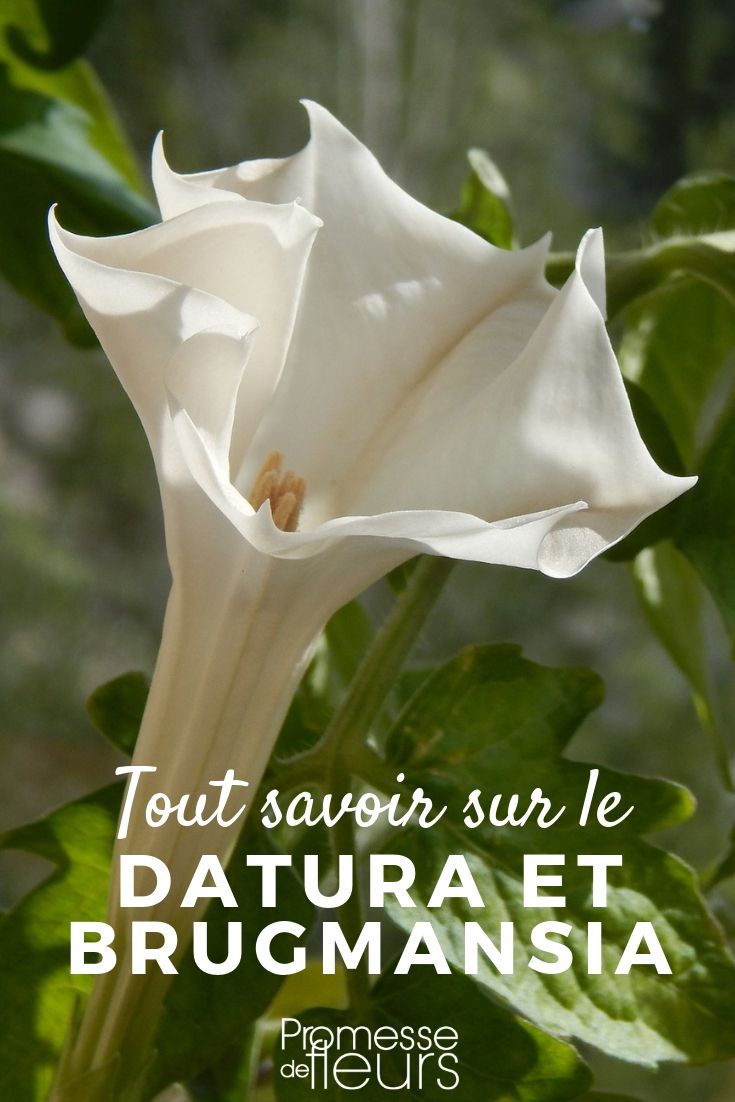































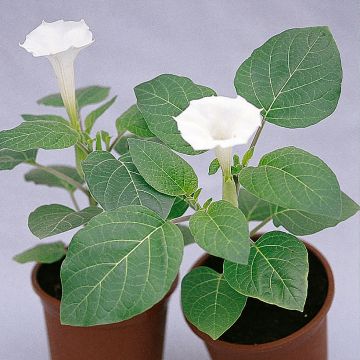




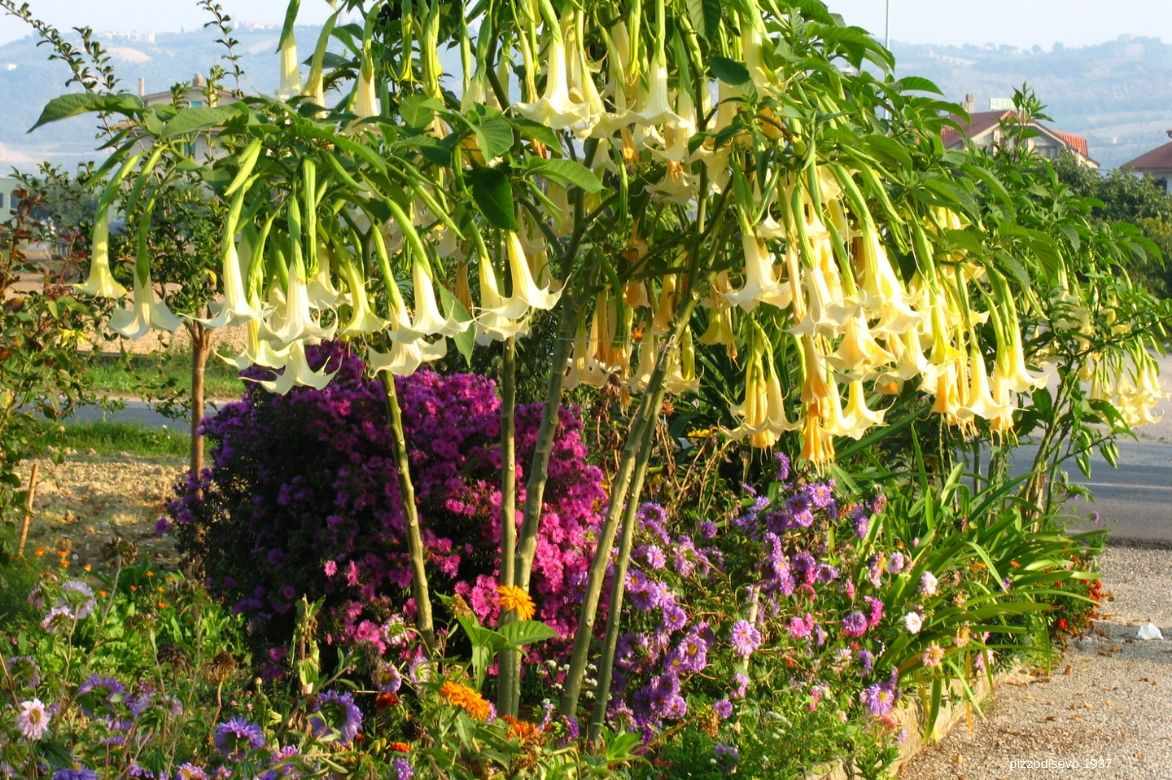
Comments